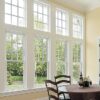There are many considerations when choosing windows, whether for replacement units or for new construction. Frame materials, glazing options, and energy efficiency are important elements. But before you make that determination, you’ll need to consider the basic operating style of the windows, each of which has its own set of advantages and disadvantages. There are also window style variations, some of which are modifications or combinations of other styles.
Most homes will have more than one style of window. But most designers advise against mixing too many different styles in one home, as it creates a disjointed look. It is very likely that when you replace a single window you will be left with the same style, but large-scale replacement of all the windows at the same time gives you the option to re-style all of them for a more radical makeover. The style of the house also plays a role in window selection because certain window styles are often associated with defined architectural styles. Magnetite Windows
Common window styles include:
- Sash windows
- Double hung with muntins
- Casement windows
- Awning windows
- Sliding windows
- Fixed windows
- Roof windows or skylights
- Bay or arch window
- Glass block windows
Here are some considerations for these popular window styles.
Double sash windows
Although you may not recognize its official name, this window style is probably the one you are most familiar with. Sash windows feature two large panes (frame units that surround the glass panes) that slide up and down within vertical rails. In older styles, the sash is offset by hidden weights in the wall pockets behind the case trim, but in modern double-sash windows, it is more common for the sash to be offset by hidden springs in the rails sides.
Double sash windows with mullions
This is a simple variation of the sash window in which the larger panes are subdivided into smaller panels within the larger frames, using a grid of horizontal and vertical mullions. In old windows or expensive new windows, the mullions may contain individual small panes of glass, but in many modern mullions the effect is an illusion created by a grille of wood or plastic pieces simply resting on a large pane of glass. class. On many double sash windows, stiles are an accessory you can add. In double or triple glazed windows, the stiles sometimes fit between the large panes of glass, giving the illusion of smaller panes of glass.
Casement windows
Casement windows are those that are cranked horizontally on hinges mounted on one side at the top and bottom. One side remains motionless, while the other side of the window opens like a door. They are very common windows, second only to sash windows in popularity.
Awning windows
Awning windows work in exactly the same way as casement windows, with mechanical cranks that open and close them. Awning windows, however, open from the bottom when turned, with the top edge fixed in place while the bottom turns out and up.
Sliding windows
Sliding windows are mechanically fairly simple, consisting of side-by-side windows that slide horizontally along the upper and lower tracks. In some styles, both windows slide, while in other styles, one window is fixed while the other is moving from side to side.
Fixed windows
A fixed window refers to any window that uses a fixed pane of glass within a window frame that does not open or close. The classic picture window is the most familiar example of a fixed window, but there are other types.
Skylights or roof windows
The terms roof window and skylight are sometimes used interchangeably, but traditionally, a skylight is defined as a fixed window installed on the roof line, while a roof window refers to a similar window that can be opened and closed to provide ventilation.
Bay or bow window
A bay or arched window refers to a combination of windows that together form a unit that extends outward from the wall surface of the house. These windows are called bay when the shape of the extension is more or less square, and they are known as arch when the shape is more curved.
Bay and arched windows are traditionally formed with a fixed central panoramic window flanked on the sides by one or more pairs of casement or double-sash windows.
Glass block windows
Glass block windows refer to fixed windows made with architectural glass blocks, usually with mortar in place. The thick blocks are usually made of semi-opaque glass that allows light to pass through, but still blocks views.

Leave a Reply